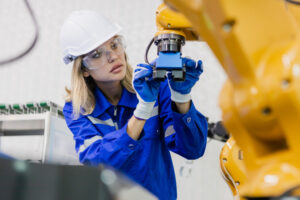
While there are challenges to overcome, cobots offer a number of benefits when they are part of a comprehensive smart manufacturing automation strategy.
Collaborative robots, known as cobots, are making an impact on the automotive smart manufacturing industry, and they could play an even more critical role in the near future. While traditional industrial robots have long been used in assembly lines for repetitive and precise tasks, cobots are designed to work alongside human operators, providing the flexibility to take on more complex tasks without massive programming efforts.
Additionally, cobots help manufacturers meet the high demands of modern production, enhance worker productivity, and often help address labor and skills shortages. But as with any new technology, implementing cobots also presents challenges. Overcoming those challenges will allow auto manufacturers to expand their use of cobots and complement broader automation efforts.
Benefits of Cobots in Auto Smart Manufacturing
Cobots can deliver higher efficiency, improved safety, and enhanced flexibility in an automaker’s production environment. These benefits can have a substantial impact on the bottom line, productivity, and worker satisfaction.
For example, unlike traditional industrial robots, which often require extensive programming and setup, cobots are more adaptable to changing production environments. They can easily be reprogrammed and redeployed for different tasks, making them ideal for the automotive industry, where production needs frequently change.
In many use cases, cobots are equipped with advanced sensors and safety mechanisms that allow them to operate safely around humans. These features can detect proximity to humans and automatically slow down or stop to prevent collisions, significantly reducing the risk of workplace injuries. In auto manufacturing environments, where heavy machinery and hazardous materials are prevalent, cobots enhance safety by taking over physically strenuous tasks that may otherwise pose risks to workers.
Furthermore, cobots can increase productivity, especially when used to perform precise tasks. To that point, cobots excel at handling repetitive tasks with high precision, helping to eliminate human errors and reduce waste. For example, cobots can assist in welding, painting, and part assembly with accuracy and consistency, which are critical to maintaining high-quality standards. By assigning repetitive tasks to cobots, human workers can focus on more complex, high-value tasks, thus improving overall productivity.
When looking at costs, cobots are generally more affordable than traditional industrial robots, making them accessible to small and medium-sized manufacturers. Their scalability allows manufacturers to gradually increase their use of automation without requiring a substantial upfront investment. That makes cobots an attractive option for companies that want to enhance productivity without straining their budgets.
And perhaps most importantly, in the current labor market, cobots can ease the skilled worker dilemma many auto manufacturers are facing today.
See also: What’s Next for Smart Factories? A Look Ahead to Industry 5.0
Challenges in Adopting Cobots
While the benefits of cobots are significant, manufacturers must address a number of issues before implementing them in production environments. Some of the top challenges include:
Complex Integration with Existing Systems: Cobots need to operate within existing industrial machinery, software, and human workflows. Integrating cobots with these systems requires careful planning, customization, and sometimes reconfiguration of legacy equipment.
Training and Skill Development: Although cobots are user-friendly compared to traditional robots, human operators must still receive adequate training to interact with them effectively. Training programs need to address not only how to operate cobots but also safety protocols and basic troubleshooting.
Enabling Human and Cobot Collaboration: Cobots are designed to work alongside humans. However, this also means that cobots must be programmed to recognize and react to a wide range of human behaviors. Designing a smooth, effective collaboration requires ongoing refinement of cobot algorithms to ensure that they respond appropriately to human actions.
See also: Human-robot Collaboration and Smart Manufacturing
Cobots as Part of a Broader Automation Strategy
Cobots are not intended to replace human labor entirely or exist in isolation; rather, they complement other automation tools and systems. In auto manufacturing, cobots can work alongside autonomous mobile robots (AMRs), traditional industrial robots, and artificial intelligence-driven systems and be part of a broader automated production environment.
For instance, cobots can handle assembly tasks alongside human workers, while traditional robots are assigned to tasks that require high-speed, repetitive movements with minimal variation. Meanwhile, AMRs can transport parts and materials throughout the facility, and AI can oversee the entire system, optimizing workflows based on real-time data. This interconnected approach not only improves productivity but also ensures flexibility, allowing manufacturers to respond to changes in production requirements or sudden disruptions.
The Future of Cobots in Smart Manufacturing Auto Plants
As automotive manufacturing evolves toward Industry 4.0, cobots are expected to play an increasingly central role in smart manufacturing plants. Their combination of adaptability, affordability, and safety makes them ideal for the smart factories of the future.
One emerging area where industry experts believe cobots will help include has to do with AI-enabled cobots. Future cobots, relying on AI and machine learning, will likely become even more autonomous and capable of handling more complex tasks. Additionally, AI-driven cobots will be able to learn from their interactions and improve their performance over time, further enhancing their value in production environments.
As cobots become more sophisticated, they will be able to engage in deeper collaboration with human workers. Future cobots may come equipped with advanced communication capabilities, allowing them to respond to verbal commands or gestures. This will allow human operators to interact with cobots in a more natural, intuitive way, improving workflow and further reducing the need for extensive training.
A Final Word
Cobots are rapidly transforming the auto manufacturing industry, offering new opportunities for productivity, safety, and operational efficiency. While there are challenges to overcome, cobots offer a number of benefits when they are part of a comprehensive automation strategy.










